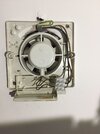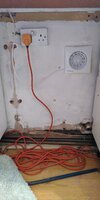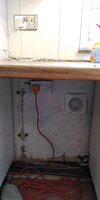- Joined
- 10 Feb 2023
- Messages
- 17
- Reaction score
- 2
- Country

Hi, I have two Primeline PEF4020 extractor fans - Fan 1 has not worked since I moved in a few months ago, and Fan 2 would come on with the light, and then after the light turned off, it ran on timer for a minute.
To test if Fan 1 had something wrong with the circuit board or the fan itself, I swapped the circuit boards of both fans with each other. Neither fans worked with this configuration, so I believe both Fan 1's circuit board and the fan itself are dead. That's fine, I'm happy to buy a quieter one anyway.
The problem started when I put the original circuit board back into Fan 2 - Now the fan is always on, regardless of if the light is on or off. After reading some things on this forum, I swapped the Permanent Live and the Switched Live which caused the fan to turn on and off at the same time as the light.
So question 1 - Does this mean that the timer component somehow got damaged when I swapped the circuit boards and now it continuously runs (when the PL and the SL are in the correct places)?
Edit: I just had a thought that even if the timer had died, would that justify the fact the fan runs even when the light is off?
Question 2 - Is it ok to leave the PL and SL swapped? To be honest I don't mind having the fan only come on with the light if it saves me having to buy another fan, so I just want to make sure it couldn't potentially cause problems.
To test if Fan 1 had something wrong with the circuit board or the fan itself, I swapped the circuit boards of both fans with each other. Neither fans worked with this configuration, so I believe both Fan 1's circuit board and the fan itself are dead. That's fine, I'm happy to buy a quieter one anyway.
The problem started when I put the original circuit board back into Fan 2 - Now the fan is always on, regardless of if the light is on or off. After reading some things on this forum, I swapped the Permanent Live and the Switched Live which caused the fan to turn on and off at the same time as the light.
So question 1 - Does this mean that the timer component somehow got damaged when I swapped the circuit boards and now it continuously runs (when the PL and the SL are in the correct places)?
Edit: I just had a thought that even if the timer had died, would that justify the fact the fan runs even when the light is off?
Question 2 - Is it ok to leave the PL and SL swapped? To be honest I don't mind having the fan only come on with the light if it saves me having to buy another fan, so I just want to make sure it couldn't potentially cause problems.
Last edited:



